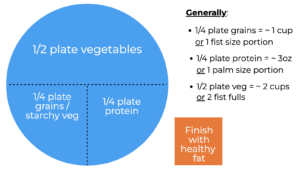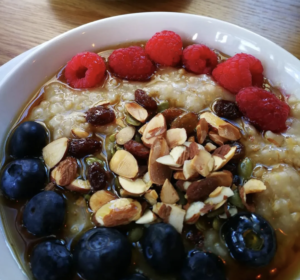The healthy plate model of eating is a go-to recommendation for people with type-1 diabetes, but do we need to follow it all of the time?
This T1D dietitian says no!
Hi friends, here’s another instalment of me breaking down one of the many T1D nutrition misconceptions out there.
The healthy plate model recommends eating a half plate vegetables, a quarter plate high fibre grains (or starchy vegetables) and a quarter plate lean protein with a small side of of healthy fats for all meals
It is the number one recommendation for us dietitians working with people that have either type-1 or type-2 diabetes.
And I’ll be 100% honest with you, it is a great model for eating.
But it is not the only way of eating.
The healthy plate is all about balance and lifestyle.

Benefits of the healthy plate
Why is the healthy plate model such a touted recommendation?
Well, it is loaded with fibre. Half that plate is not going to impact blood sugars or at the very least minimally impact them. It also emphasizes lower-fat, healthy fat, whole grain, whole food options for eating.
All of that is a potential benefit to blood sugars.
Our bodies cannot digest fibre. Any carbohydrate that is high fibre, or attached to other foods that are high in fibre, will have a slower release of sugars into our blood stream. That means, blood sugar spikes will theoretically be reduced.
Foods on that healthy plate that help with this are:
- Non-starchy vegetables: ie. leafy greens, broccoli, cucumber, peppers, beets
- High fibre grains: quinoa, ie. barley, brown rice, bulgur, buckwheat, oats
- Plant-based proteins: ie. beans and lentils
Protein is another food that when paired with carbohydrates will help slow down the release of sugars from the carbohydrates. This is because most proteins, both animal and plant-based, have so much texture to them that it takes work for the body to break them down.
Low fat is good because, as many of us in the T1D world have experienced, excess fat in a meal can shoot up blood sugars several hours after a meal. Fat essentially paralyzes the carbs from breaking down until the fat has completely digested. This is unlike protein and fibre, which allows carbs to break down at the same time as the protein and fibre.
And finally, that healthy plate limits processed foods, which decreases sodium and excess fats.
The limitations of the healthy plate
But the healthy plate model doesn’t cover all life scenarios.
If I’m training for a marathon, my body needs way more energy than the healthy plate model is going to provide.
Energy predominantly comes from carbohydrates. And while high fibre is great for meals that are not close to training time, I don’t want that fibre if I’m eating close to exercise. I want the carbohydrates I’m eating to get into my muscles quick – low-fibre carbs work best for that.
Plus, fibre can also increase stomach discomfort during training sets. I do not want that!
And what about breakfast? Am I really going to eat a half plate of vegetables at 6:30 in the morning? Some people may, but me, no thank you!
My breakfast is a bowl, not a plate, with mostly high fibre grains, a little bit of high fibre fruit, and a little bit of protein. That works for me and my T1D.
Social settings can also be a challenge. I don’t want you to think that you can’t eat by the healthy plate model at a restaurant; you certainly can. But sometimes, a person wants comfort food that doesn’t necessarily fit with the healthy plate. And sometimes, that’s okay.
If most of the time we are following the healthy plate model, those sometimes that we indulge in our cravings or our comforts are not going to harm us.

Final words on the healthy plate
Balancing nutrition is similar to balancing diabetes – if we’re in target with our eating and our blood sugars more than 70% of the time, we are doing fantastic.
Food is more than just nutrition; I cannot emphasize that enough.

